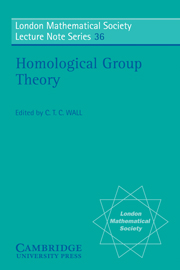Book contents
- Frontmatter
- Contents
- Preface
- Introduction
- 1 Traces and Euler characteristics
- 2 Groups of virtually finite dimension
- 3 Free abelianised extensions of finite groups
- 4 Arithmetic groups
- 5 Topological methods in group theory
- 6 An example of a finite presented solvable group
- 7 SL3(Fq[t]) is not finitely presentable
- 8 Two-dimensional Poincaré duality groups and pairs
- 9 Metabelian quotients of finitely presented soluble groups are finitely presented
- 10 Soluble groups with coherent group rings
- 11 Cohomological aspects of 2-graphs. II
- 12 Recognizing free factors
- 13 Trees of homotopy types of ( m)-complexes
- 14 Geometric structure of surface mapping class groups
- 15 Cohomology theory of aspherical groups and of small cancellation groups
- 16 Finite groups of deficiency zero
- 17 Äquivalenzklassen von Gruppenbeschreibungen, Identitäten und einfacher Homotopietyp in niederen Dimensionen
- 18 Two-dimensional complexes with torsion values not realizable by self-equivalences
- 19 Applications of Nielsen's reduction method to the solution of combinatorial problems in group theory: a survey
- 20 Chevalley groups over polynomial rings
- List of problems
16 - Finite groups of deficiency zero
Published online by Cambridge University Press: 05 April 2013
- Frontmatter
- Contents
- Preface
- Introduction
- 1 Traces and Euler characteristics
- 2 Groups of virtually finite dimension
- 3 Free abelianised extensions of finite groups
- 4 Arithmetic groups
- 5 Topological methods in group theory
- 6 An example of a finite presented solvable group
- 7 SL3(Fq[t]) is not finitely presentable
- 8 Two-dimensional Poincaré duality groups and pairs
- 9 Metabelian quotients of finitely presented soluble groups are finitely presented
- 10 Soluble groups with coherent group rings
- 11 Cohomological aspects of 2-graphs. II
- 12 Recognizing free factors
- 13 Trees of homotopy types of ( m)-complexes
- 14 Geometric structure of surface mapping class groups
- 15 Cohomology theory of aspherical groups and of small cancellation groups
- 16 Finite groups of deficiency zero
- 17 Äquivalenzklassen von Gruppenbeschreibungen, Identitäten und einfacher Homotopietyp in niederen Dimensionen
- 18 Two-dimensional complexes with torsion values not realizable by self-equivalences
- 19 Applications of Nielsen's reduction method to the solution of combinatorial problems in group theory: a survey
- 20 Chevalley groups over polynomial rings
- List of problems
Summary
The aim of this survey is to give a catalogue of known finite groups with deficiency zero. The deficiency of a finite presentation 〈x∣R〉 is ∣X∣ - ∣R∣, and the deficiency def G of a group G is the maximum of this number taken over all finite presentations of G. It is easy to show [21, Theorem 2. 6] that finite groups have non-positive deficiency, so we are dealing with an extremal case. It was known to Schur [34] that the multiplicator M(G) of a finite group G can be generated by -def G elements, and G is called efficient [15] if M(G) needs this many generators. While not all finite groups are efficient [36], the problem remains open in the nilpotent case. For more information on this and other related problems on minimal presentations, we refer the reader to the survey [42].
The ordering of our sections is basically chronological, according to the date of the first significant appearance of groups of the corresponding type, and we approach each section modulo its predecessors, crossreferencing where appropriate. Our notational conventions are fairly standard so that, for example, (a, b) denotes the highest common factor of the integers a, b, and [x, y] = x− y− xy = x− xy for x, y members of a group G. The number of invariant factors of a finite abelian group is often referred to as its rank.
- Type
- Chapter
- Information
- Homological Group Theory , pp. 275 - 290Publisher: Cambridge University PressPrint publication year: 1979
- 17
- Cited by

